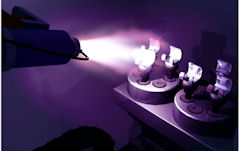If you want to get a sense of how government can usefully engage itself in promoting Virginia’s manufacturing sector, consider the Commonwealth Center for Advancing Manufacturing (CCAM) in Prince George County near Petersburg. The not-for-profit center has created a venue where corporations collaborate to test the latest high-tech manufacturing equipment — like a new plasma sprayer recently donated by Sulzer Merco, a Swiss company — on a commercial scale.
“This space is designed exactly the way you would see it if you went to any modern, advanced manufacturing factory,” Executive Director Dave Lohr told the Times-Dispatch. “When we test technology here, we are taking the scale-up risk out of it.”
The consortium got its start when Rolls Royce announced plans to build a $500 million aircraft-engine components plant in Prince George. Modeling the site on other R&D facilities it has backed in the United Kingdom, the British company donated 20 acres near its 1,000-acre plant. The 60,000-square-foot building is owned by the University of Virginia Foundation. Construction was financed with $2.5 million in funding from the Virginia Tobacco Indemnification and Community Revitalization Commission, $4 million from the federal Economic Development Administration and a portion of $5 million in state recovery bonds.
Private companies joining the consortium as Tier 1 members pledge $400,000 annually along with equipment and research support. Organizing members include Rolls Royce, Canon Virginia, Newport News Shipbuilding, Siemens, Chromalloy, Sandvik Coromant and Sulzer Metco. Additionally, the University of Virginia, Virginia Tech and Virginia State University participate by contributing the efforts of faculty and graduate students.
Bacon’s bottom line: Government funding was instrumental in getting CCAM off the ground. But there are tremendous differences between backing CCAM and, say, the government-as-sugar-daddy model that has squandered billions of dollars on Solyndra and other failed alternate-energy enterprises. First, in supporting CCAM, government is supporting research. It is not underwriting privately owned commercial enterprises. Second, government is supporting a not-for-profit enterprise that has painstakingly assembled buy-in from three universities and numerous private corporations, constituting proof that there is real-world demand for what it does. The government is not picking winners and losers. It is taking very little risk.
Rather than devoting funds to entice individual companies to invest in Virginia — such as the dubious $2 million contribution to Celanese Corporation (see here and here) — discretionary funds available to Virginia’s governor would be better invested in consortia like CCAM. One prospect for consideration would be the Virginia Logistics Research Center, which models itself on CCAM.
Corporations come and go from Virginia with disturbing frequency. Investments in knowledge creation and innovation have a much longer half life.
— JAB



